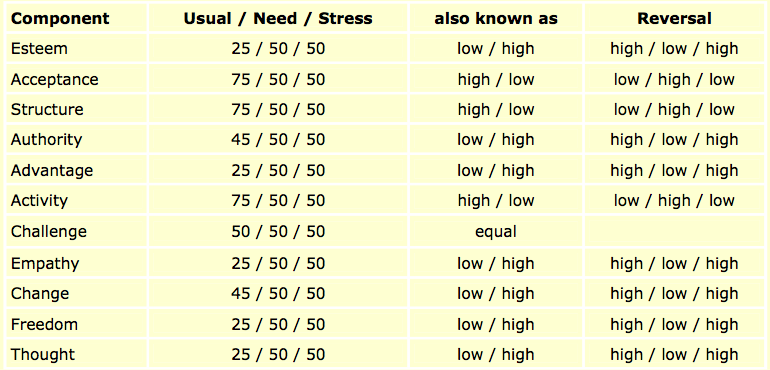|
|
|
|
|
|
| Most individuals (approximately 70% of the population) who complete the Birkman Questionnaire are in alignment with these socialized patterns or norms. When an individual’s scores align to this socialized pattern, the Stress score will be the same value as the Needs score. This indicates that the resulting Stress will be in direct relationship to the underlying Need not being met.
Approximately 10% of the time scores will follow a pattern of low/low/low; and approximately 10% of the time the pattern will be high/high/high. In certain instances (again, about 10%), an individual may have a Usual/Need pattern that does not conform to the dominant social pattern but actually reverses it. In Birkman terms, this is called a reversal. If an indiviudal has a reversed social pattern on a Component, we know that the Stress Behavior will be different than one may expect. The Stress score in these instances will go to a 75 or 25. |
|
Norms and the Interpretive Process
During interpretations there are times when discussing the individual’s results as they compare to the norms will be important. Things to look for when reviewing results include:
-
Does the person have any reversals?
A person who has a reversal has answered the questions relating to that component in an opposite way than the majority of the population. This indicates that the person views himself differently than most. For example, on Esteem the norm is low/high/high which means that most people usually view themselves as more candid than others typically are, and that they need others to be a little less candid with them. The person who has a reversal, however; feels that he is more sensitive, tactful and diplomatic than most and he expects others to be more candid and straightforward than he is. Their entire outlook is different than the norm.
Also important to note is that the behaviors a person with a reversal exhibits will not be an indication of his or her needs. Staying with the Esteem example, the reversal pattern is high/low/high – meaning that both the Usual and the Stress behaviors will be high, while the need is low. It becomes critical for the person with a reversal to be aware of his or her needs and to be able to communicate those needs to others since the behaviors won’t give any indication. As you can imagine, it becomes even more important to be able to communicate these needs if a person has multiple reversals.
-
Does the person have wide gaps in numerical scores between the usual and the need?
Large differences between the usual and the need scores can both follow the norm and can reverse the norm (be reversals). Both can be important to discuss during an interpretation. Large differences between the Usual and the Need that follow the normative pattern will typically be seen in individuals with a low Challenge score – those individuals who consistently answered more questions about self in a positive light and more questions about most people in a less positive manner (see Birkman Beginnings Edition 11 for more on this).
Wide gaps between the Usual and Need score when the score for that component is also a reversal indicate an even greater need for the individual to be aware of his or her needs and to have a way to communicate those needs to others – this is because the person’s Usual and Stress behaviors are so different from the Need. Many times a person with a wide reversal truly feels understood for the first time when hearing the Birkman results. It is usually not a surprise to them – in fact, often it is a confirmation that they feel differently than most on a particular Component. The consultant then should spend time helping the individual with ways to communicate those needs to others.
• Does the person have multiple Components that do not follow the norm, but are not reversals (the 10% that are low/low/low and the 10% that are high/high/high)?
In these cases the individuals have the advantage of their behaviors giving a good idea of what they need – the way they act IS the way they want to be treated; but, there can be a down side which is that they may not have a good understanding of what the “rest of the world” is doing or what they need.


